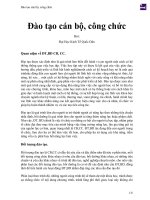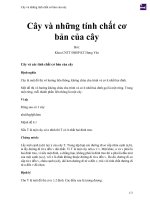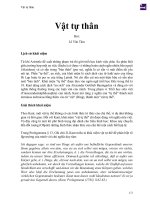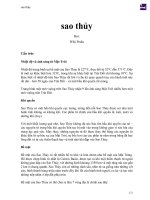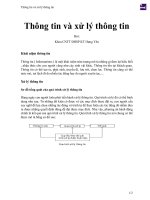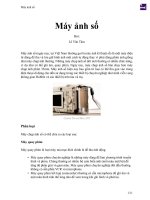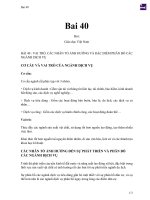Tài liệu PDF Linear Equations
Bạn đang xem bản rút gọn của tài liệu. Xem và tải ngay bản đầy đủ của tài liệu tại đây (451.97 KB, 9 trang )
Linear Equations
Linear Equations
By:
OpenStaxCollege
Linear regression for two variables is based on a linear equation with one independent
variable. The equation has the form:
y = a + bx
where a and b are constant numbers.
The variable x is the independent variable, and y is the dependent variable.
Typically, you choose a value to substitute for the independent variable and then solve
for the dependent variable.
The following examples are linear equations.
y = 3 + 2x
y = –0.01 + 1.2x
Try It
Is the following an example of a linear equation?
y = –0.125 – 3.5x
yes
The graph of a linear equation of the form y = a + bx is a straight line. Any line that is
not vertical can be described by this equation.
Graph the equation y = –1 + 2x.
1/9
Linear Equations
Try It
Is the following an example of a linear equation? Why or why not?
No, the graph is not a straight line; therefore, it is not a linear equation.
Aaron's Word Processing Service (AWPS) does word processing. The rate for services
is $32 per hour plus a $31.50 one-time charge. The total cost to a customer depends on
the number of hours it takes to complete the job.
Find the equation that expresses the total cost in terms of the number of hours required
to complete the job.
Let x = the number of hours it takes to get the job done.
Let y = the total cost to the customer.
The $31.50 is a fixed cost. If it takes x hours to complete the job, then (32)(x) is the cost
of the word processing only. The total cost is: y = 31.50 + 32x
Try It
Emma’s Extreme Sports hires hang-gliding instructors and pays them a fee of $50 per
class as well as $20 per student in the class. The total cost Emma pays depends on the
2/9
Linear Equations
number of students in a class. Find the equation that expresses the total cost in terms of
the number of students in a class.
y = 50 + 20x
Slope and Y-Intercept of a Linear Equation
For the linear equation y = a + bx, b = slope and a = y-intercept. From algebra recall that
the slope is a number that describes the steepness of a line, and the y-intercept is the y
coordinate of the point (0, a) where the line crosses the y-axis.
Three possible graphs of y = a + bx. (a) If b > 0, the line slopes upward to the right. (b) If b = 0,
the line is horizontal. (c) If b < 0, the line slopes downward to the right.
Svetlana tutors to make extra money for college. For each tutoring session, she charges
a one-time fee of $25 plus $15 per hour of tutoring. A linear equation that expresses the
total amount of money Svetlana earns for each session she tutors is y = 25 + 15x.
What are the independent and dependent variables? What is the y-intercept and what is
the slope? Interpret them using complete sentences.
The independent variable (x) is the number of hours Svetlana tutors each session. The
dependent variable (y) is the amount, in dollars, Svetlana earns for each session.
The y-intercept is 25 (a = 25). At the start of the tutoring session, Svetlana charges a
one-time fee of $25 (this is when x = 0). The slope is 15 (b = 15). For each session,
Svetlana earns $15 for each hour she tutors.
Try It
Ethan repairs household appliances like dishwashers and refrigerators. For each visit, he
charges $25 plus $20 per hour of work. A linear equation that expresses the total amount
of money Ethan earns per visit is y = 25 + 20x.
What are the independent and dependent variables? What is the y-intercept and what is
the slope? Interpret them using complete sentences.
3/9
Linear Equations
The independent variable (x) is the number of hours Ethan works each visit. The
dependent variable (y) is the amount, in dollars, Ethan earns for each visit.
The y-intercept is 25 (a = 25). At the start of a visit, Ethan charges a one-time fee of $25
(this is when x = 0). The slope is 20 (b = 20). For each visit, Ethan earns $20 for each
hour he works.
References
Data from the Centers for Disease Control and Prevention.
Data from the National Center for HIV, STD, and TB Prevention.
Chapter Review
The most basic type of association is a linear association. This type of relationship can
be defined algebraically by the equations used, numerically with actual or predicted
data values, or graphically from a plotted curve. (Lines are classified as straight curves.)
Algebraically, a linear equation typically takes the form y = mx + b, where m and b
are constants, x is the independent variable, y is the dependent variable. In a statistical
context, a linear equation is written in the form y = a + bx, where a and b are the
constants. This form is used to help readers distinguish the statistical context from the
algebraic context. In the equation y = a + bx, the constant b that multiplies the x variable
(b is called a coefficient) is called as the slope. The slope describes the rate of change
between the independent and dependent variables; in other words, the rate of change
describes the change that occurs in the dependent variable as the independent variable
is changed. In the equation y = a + bx, the constant a is called as the y-intercept.
Graphically, the y-intercept is the y coordinate of the point where the graph of the line
crosses the y axis. At this point x = 0.
The slope of a line is a value that describes the rate of change between the independent
and dependent variables. The slope tells us how the dependent variable (y) changes for
every one unit increase in the independent (x) variable, on average. The y-intercept
is used to describe the dependent variable when the independent variable equals zero.
Graphically, the slope is represented by three line types in elementary statistics.
Formula Review
y = a + bx where a is the y-intercept and b is the slope. The variable x is the independent
variable and y is the dependent variable.
4/9
Linear Equations
Use the following information to answer the next three exercises. A vacation resort rents
SCUBA equipment to certified divers. The resort charges an up-front fee of $25 and
another fee of $12.50 an hour.
What are the dependent and independent variables?
dependent variable: fee amount; independent variable: time
Find the equation that expresses the total fee in terms of the number of hours the
equipment is rented.
Graph the equation from [link].
Use the following information to answer the next two exercises. A credit card company
charges $10 when a payment is late, and $5 a day each day the payment remains unpaid.
Find the equation that expresses the total fee in terms of the number of days the payment
is late.
Graph the equation from [link].
5/9
Linear Equations
Is the equation y = 10 + 5x – 3x2 linear? Why or why not?
Which of the following equations are linear?
a. y = 6x + 8
b. y + 7 = 3x
c. y – x = 8x2
d. 4y = 8
y = 6x + 8, 4y = 8, and y + 7 = 3x are all linear equations.
Does the graph show a linear equation? Why or why not?
[link] contains real data for the first two decades of AIDS reporting.
Adults and Adolescents only, United States
Year
# AIDS cases diagnosed # AIDS deaths
Pre-1981 91
29
1981
319
121
1982
1,170
453
1983
3,076
1,482
1984
6,240
3,466
1985
11,776
6,878
1986
19,032
11,987
6/9
Linear Equations
1987
28,564
16,162
1988
35,447
20,868
1989
42,674
27,591
1990
48,634
31,335
1991
59,660
36,560
1992
78,530
41,055
1993
78,834
44,730
1994
71,874
49,095
1995
68,505
49,456
1996
59,347
38,510
1997
47,149
20,736
1998
38,393
19,005
1999
25,174
18,454
2000
25,522
17,347
2001
25,643
17,402
2002
26,464
16,371
Total
802,118
489,093
Use the columns "year" and "# AIDS cases diagnosed. Why is “year” the independent
variable and “# AIDS cases diagnosed.” the dependent variable (instead of the reverse)?
The number of AIDS cases depends on the year. Therefore, year becomes the
independent variable and the number of AIDS cases is the dependent variable.
Use the following information to answer the next two exercises. A specialty cleaning
company charges an equipment fee and an hourly labor fee. A linear equation that
expresses the total amount of the fee the company charges for each session is y = 50 +
100x.
What are the independent and dependent variables?
What is the y-intercept and what is the slope? Interpret them using complete sentences.
7/9
Linear Equations
The y-intercept is 50 (a = 50). At the start of the cleaning, the company charges a onetime fee of $50 (this is when x = 0). The slope is 100 (b = 100). For each session, the
company charges $100 for each hour they clean.
Use the following information to answer the next three questions. Due to erosion, a river
shoreline is losing several thousand pounds of soil each year. A linear equation that
expresses the total amount of soil lost per year is y = 12,000x.
What are the independent and dependent variables?
How many pounds of soil does the shoreline lose in a year?
12,000 pounds of soil
What is the y-intercept? Interpret its meaning.
Use the following information to answer the next two exercises. The price of a single
issue of stock can fluctuate throughout the day. A linear equation that represents the
price of stock for Shipment Express is y = 15 – 1.5x where x is the number of hours
passed in an eight-hour day of trading.
What are the slope and y-intercept? Interpret their meaning.
The slope is –1.5 (b = –1.5). This means the stock is losing value at a rate of $1.50 per
hour. The y-intercept is $15 (a = 15). This means the price of stock before the trading
day was $15.
If you owned this stock, would you want a positive or negative slope? Why?
Homework
For each of the following situations, state the independent variable and the dependent
variable.
1. A study is done to determine if elderly drivers are involved in more motor
vehicle fatalities than other drivers. The number of fatalities per 100,000
drivers is compared to the age of drivers.
2. A study is done to determine if the weekly grocery bill changes based on the
number of family members.
3. Insurance companies base life insurance premiums partially on the age of the
applicant.
4. Utility bills vary according to power consumption.
8/9
Linear Equations
5. A study is done to determine if a higher education reduces the crime rate in a
population.
1. independent variable: age; dependent variable: fatalities
2. independent variable: # of family members; dependent variable: grocery bill
3. independent variable: age of applicant; dependent variable: insurance premium
4. independent variable: power consumption; dependent variable: utility
5. independent variable: higher education (years); dependent variable: crime rates
Piece-rate systems are widely debated incentive payment plans. In a recent study of loan
officer effectiveness, the following piece-rate system was examined:
% of
goal
reached
<
80
80
$4,000 with an
n/ additional $125
Incentive
a added per percentage
point from 81–99%
100
120
$6,500 with an
additional $125 added
per percentage point
from 101–119%
$9,500 with an
additional $125 added
per percentage point
starting at 121%
If a loan officer makes 95% of his or her goal, write the linear function that applies based
on the incentive plan table. In context, explain the y-intercept and slope.
9/9
